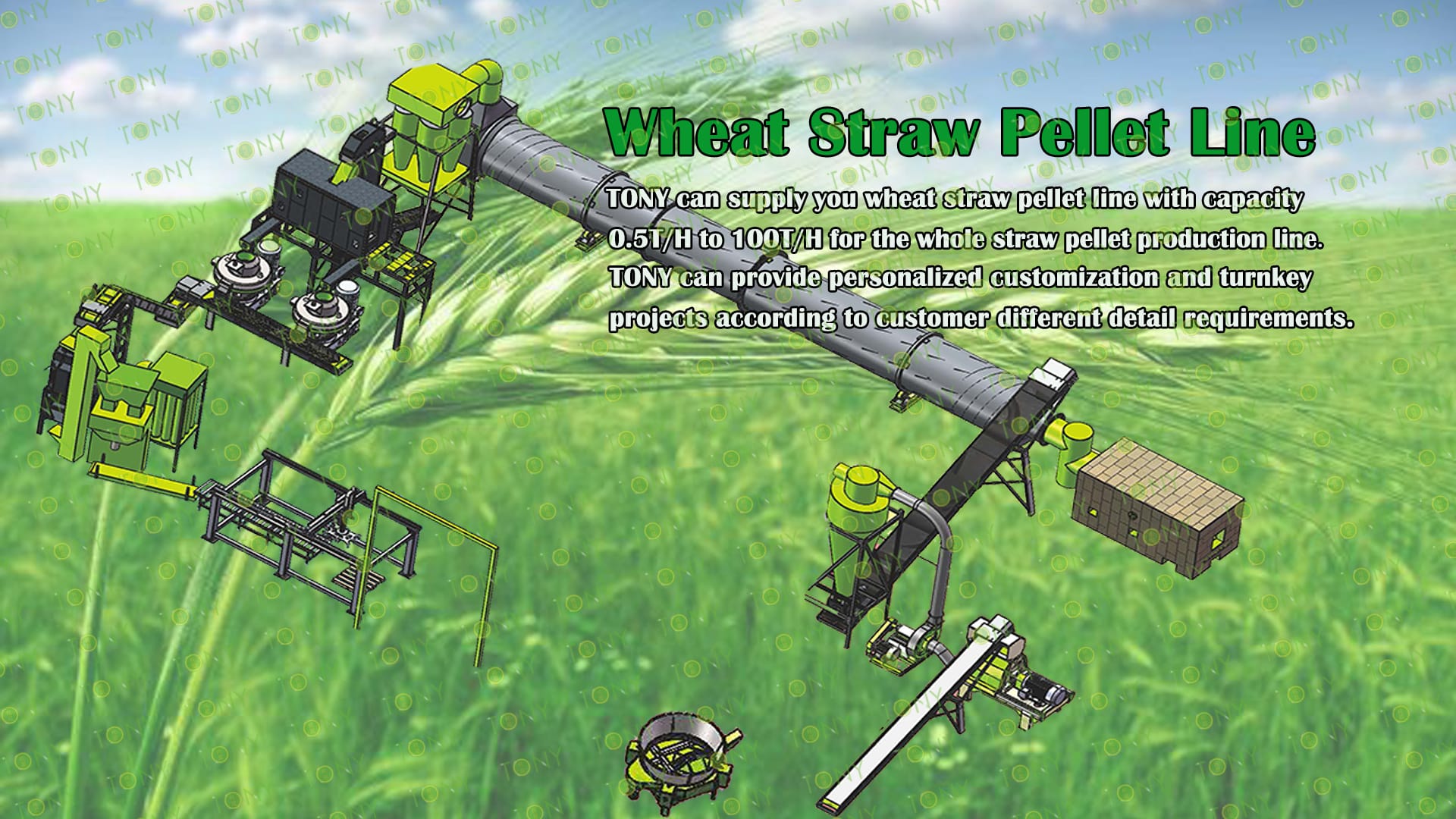
TONY Design 3-4Ton/Hour Wheat Straw Pellet Production Line Specification
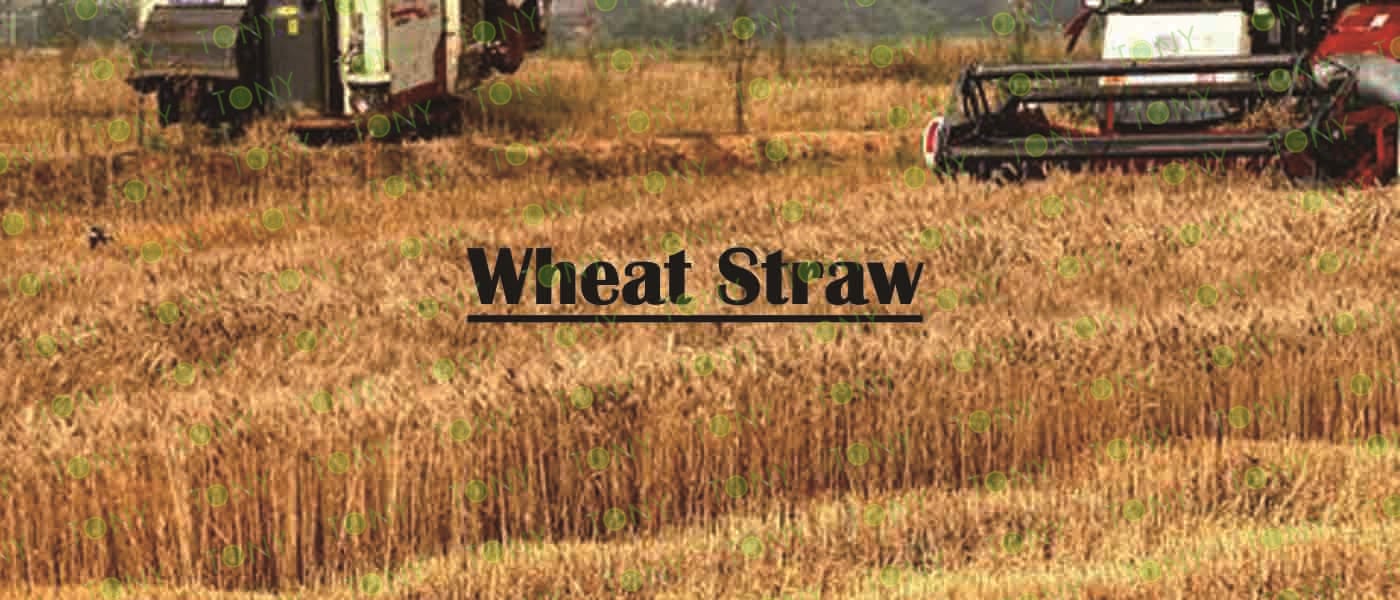
Overview of global straw resource distribution
1. Overview of global straw resources
Straw is the residue of immature parts of crops and is an important agricultural by-product. Straw can not only be used as animal feed and fertilizer, but also can be used in biomass energy, pulp and paper, biomedicine and other fields. According to statistics, there are more than 100 plants in the world that can produce straw, of which the top 10 plants that account for straw production are corn, rice, wheat, soybeans, peanuts, cotton, potatoes, sugarcane, cranberries and wheatgrass.
2. Distribution of straw resources
1). Asia
Asia is one of the regions with the richest straw resources in the world, including China, India, Pakistan, Vietnam and so on. China is one of the countries with the most abundant straw resources in Asia, with an annual output of more than 2 billion tons of straw, most of which is used for the production of biomass energy and organic fertilizer.
2). Europe
Europe is one of the regions with relatively rich straw resources in the world, including Russia, France, Germany, Poland and so on. Eu countries regard straw as a renewable energy source, and straw plays an important role in EU energy consumption.
3). North America
North American countries, including the United States, Canada and Mexico, these countries are rich in straw resources, mainly used in power generation, production of paper, biodiesel and other fields.
4). Africa
Africa is one of the regions where straw resources are relatively scarce, most of the straw is used as fuel, and a small amount is used for fertilizer and feed.
5). South America
Resources in South American countries are relatively scarce, and straw is mainly used in the production of pulp and paper, animal feed and fertilizer.
6). Australia
Australia's straw resources are relatively limited and are mainly used for the production of biomass fuels and fertilizers.
3. Conclusion
From a global perspective, straw resources are abundant in Asia, Europe and North America, while rare in South America, Africa and Australia. Among them, China is one of the countries with the largest output of straw. In the future, with the continuous enhancement of environmental awareness, the utilization value of straw resources will continue to be excavated.
Wheat Straw Burning Has Many Disadvantages But No Benefits
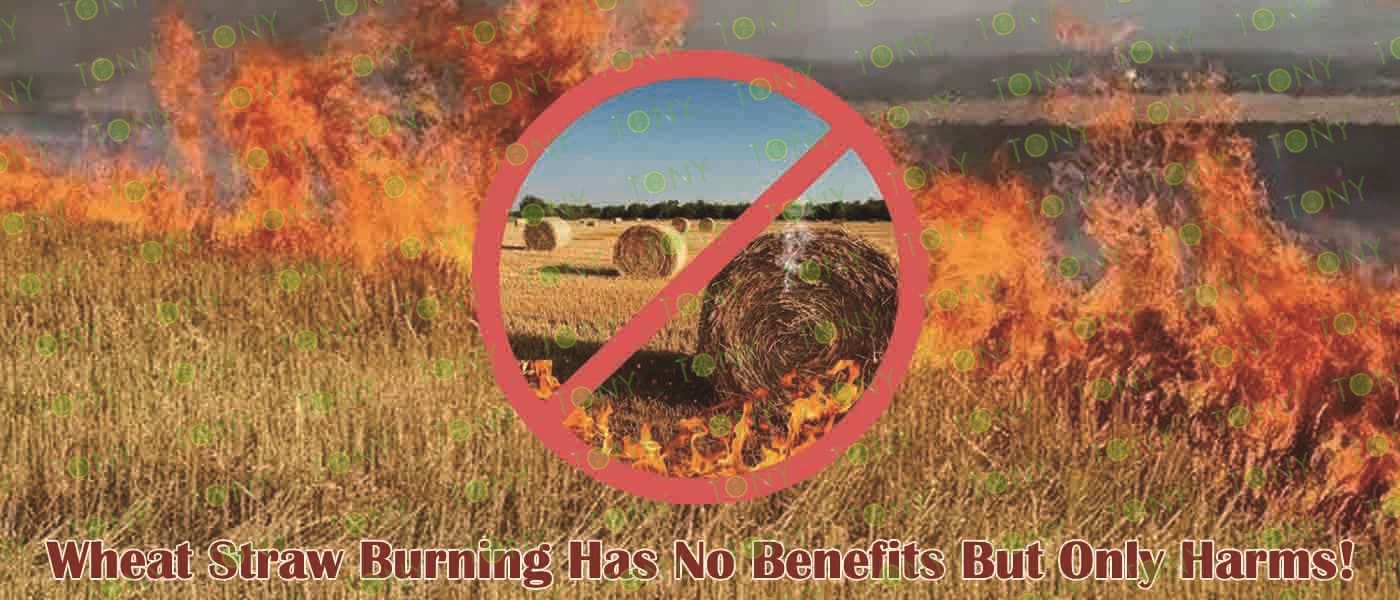
The main reasons for banning wheat straw burning include environmental pollution, health hazards, fire risks and traffic safety issues.
Environmental Pollution
Burning wheat straw will produce a large number of soot, particulate matter and harmful gases, such as sulfur dioxide, nitrogen oxides and hydrocarbons, which will cause serious pollution to the atmospheric environment. Especially the newly harvested straw is not dry, incomplete combustion will produce a lot of nitrogen oxides, sulfur dioxide and hydrocarbons, and even under the action of sunlight will produce a secondary pollutant ozone . In addition, burning straw can also produce strong carcinogens dioxins, which pose a threat to human health .
Health Hazard
The smoke produced by burning straw contains a large number of nitrogen oxides, photochemical oxidants and suspended particles, which can irritate the mucous membranes of the eyes, nose and throat, causing cough, chest congestion and tears, and may lead to bronchitis . The impact is particularly severe for the elderly and children, as well as those with respiratory illnesses .
Fire Risk
Burning straw is very easy to ignite the flammable materials around, especially near the village, once it causes a fire, the consequences will be unimaginable. Sparks from the burning process could also start wheat field fires, resulting in economic losses .
Traffic Safety
Smoke from straw burning will reduce air visibility, affect road traffic and aviation safety, and easily cause traffic accidents . The effect is particularly pronounced on both sides of main traffic lines and near airports .
Soil Damage
Straw burning will destroy the soil structure, kill the beneficial microorganisms in the soil, affect the absorption of soil nutrients by crops, lead to the decline of farmland quality, and affect the yield and quality of crops .
Legal Constraint
According to the Air Pollution Prevention Law of the People's Republic of China, illegal burning of crop residues will be punished. In addition, the Law of the People's Republic of China on Penalties for the Administration of Public Security also makes clear provisions on intentionally burning other people's crop stalks and obstructing state functionors from performing their duties .
To sum up, the prohibition of wheat straw burning is to reduce environmental pollution, protect human health, prevent fires, ensure traffic safety and maintain soil structure.

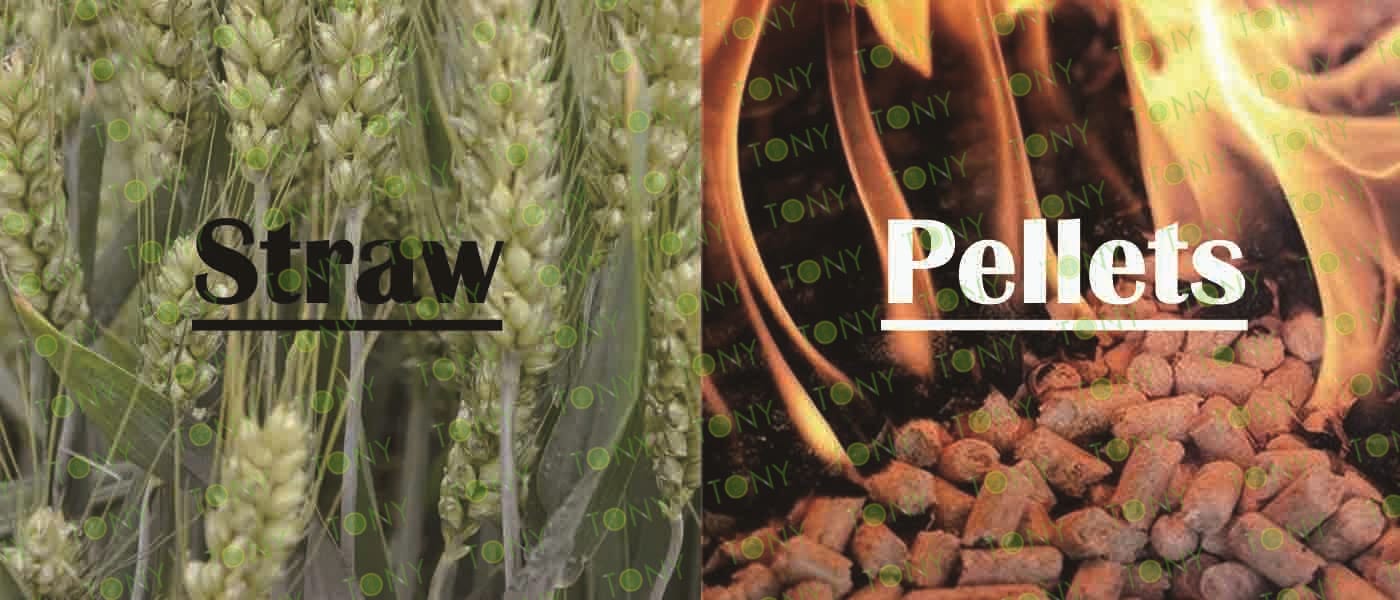
As soon as the wheat harvest season, the treatment of wheat straw will be put on the agenda, under the strong advocacy of many countries, the straw burning ban has made great progress, but for many farmers, how to deal with straw is still a big problem.
Wheat straw is a very valuable biomass energy in agricultural ecosystem. The use of wheat straw to produce biomass pellets, instead of traditional coal resources as fuel, has entered the industrialization stage, and the technology is gradually mature. Biomass pellets made from wheat straw are a kind of clean energy. Compared with coal fuel, they are clean and clean, with low pollutant emission and high thermal efficiency. Another important aspect is that they can greatly improve the comprehensive utilization of crop straw resources and realize the transformation of waste into treasure. It is of great significance to increase farmers' income, protect environment, save resources and sustainable development of agricultural economy.
As an investment project, wheat straw pellet production line has high return on investment and broad application prospects, especially for those owners who have a large number of wheat straw resources, raw materials have no cost, and can realize the transformation from raw materials to finished products.
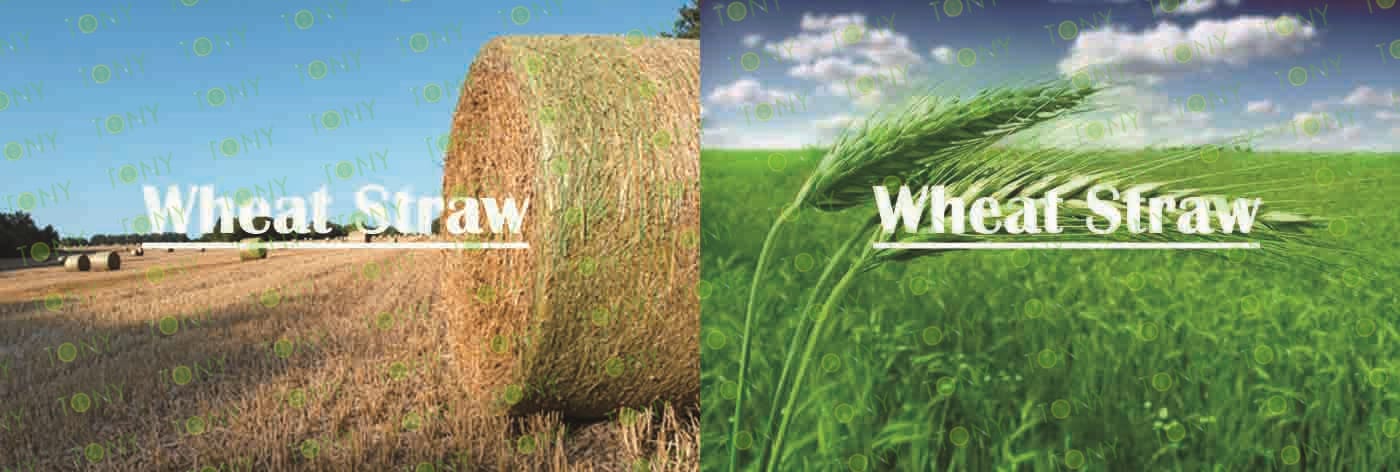
After being pressed and solidified, wheat straw becomes a biomass pellet fuel, which has the characteristics of high calorific value, complete combustion and no pollution. It is a kind of clean fuel that meets environmental protection requirements and can replace coal. In the wave of green development, wheat straw particles are becoming more and more popular, the product can not only be used as a fuel specification, widely used in biomass power plants, biomass boilers, paper mills, food factories, etc., can also be used for home heating, home cleaning, as long as the need for heat sources, biomass particles can be used, then, What are the factors that affect the yield of wheat straw pellets?
1. Impact Of Production Environment:
(1) Because the humidity of wheat straw raw materials is different in different weather environments, the higher the humidity, the less ideal the crushing effect, and the lower the yield
(2) The instability of the power environment will also affect the normal operation of the equipment, and the high and low voltage will affect the equipment and the output, especially when the voltage is too high, it will damage the equipment.
2. Equipment Maintenance And Maintenance:
The good running condition of the equipment is an important premise to improve its work efficiency. In ordinary use, users must pay attention to the maintenance of the equipment, which can achieve the dual purpose of improving production efficiency and extending service life.
3. Operation Specifications:
The equipment operator of the wheat straw granule production line must be professionally trained, have a comprehensive understanding of the performance of the equipment, and use the equipment reasonably according to the correct operation norms, which can not only ensure their personal safety but also ensure the production efficiency of the equipment.
4. Selection Of Production Line Equipment
Wheat straw pellet production line requires multiple equipment to work together. In particular, the quality of the core equipment straw granulator plays a decisive role, and some poor quality granulator equipment is shoddy. The service life is generally not very long, and the failure rate is high, and the work is delayed, which seriously affects the normal production of customers. Tony is more than 20 years of granular production line processing industry experience, the industry reputation is very good, you can visit the factory to buy.
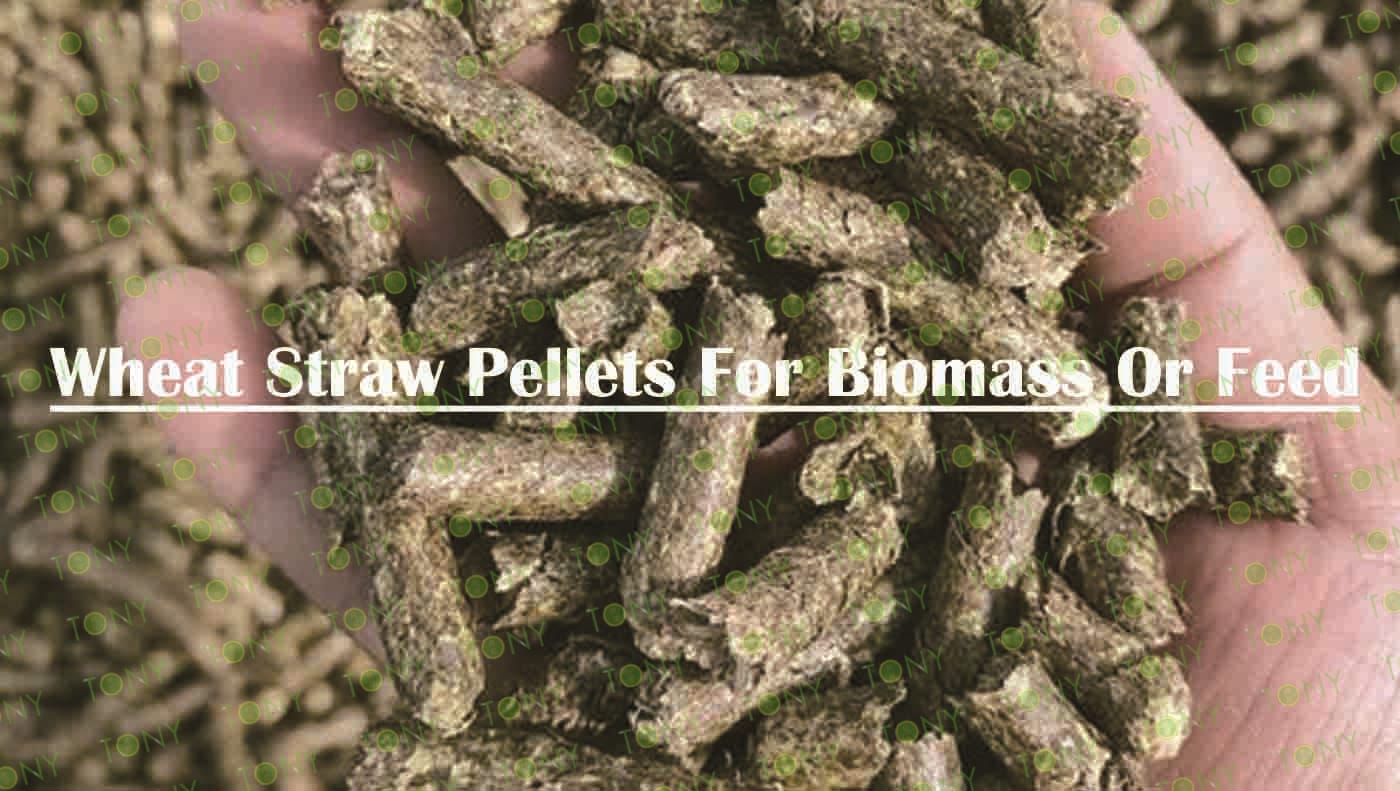

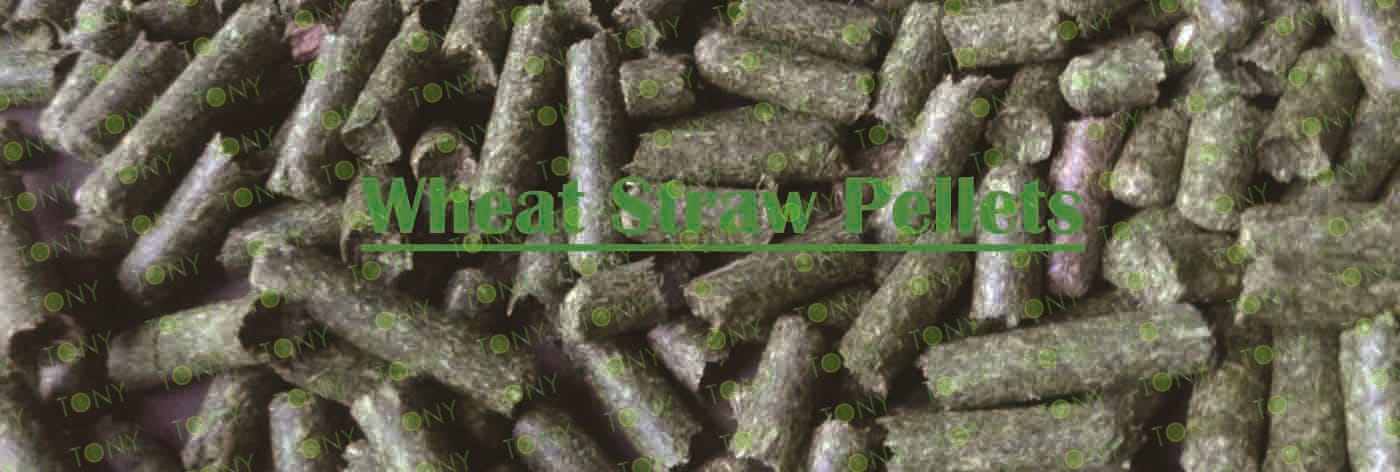
The economic benefits of Wheat Straw pellets are very significant. Wheat Straw is pressed into grains, as a biomass fuel, its benefits are mainly reflected in the following aspects,You can contact TONY for more details.
1. Economic Benefits
(1) Raw material cost estimation: The raw material of granular fuel is wheat straw, which has a large amount of resources in rural areas, and was previously incinerated on the spot. If you have wheat straw resources, then the raw material cost is basically 0, if you need to purchase wheat straw as raw materials for biomass pellets, the cost price is also very low
(2) Other costs include fuel and power costs, wages and benefits, equipment depreciation, loan interest, etc., because many countries support the use of waste crop resources for biomass fuel, and the state also supports subsidies, so this part of the cost is also very low
(3) Select the wheat straw pellet production line project to process wheat straw into a certain size of granular fuel, with high calorific value, good strength, low pollutant content, stable performance and good economy.It's a good investment
2. Environmental Benefits
Improper disposal of wheat straw will produce certain pollution to the environment. The wheat straw is made into pellet fuel, which is burned by a special gasification boiler with a thermal efficiency of 81%, CO, S0, and close to zero emissions, which can replace non-renewable fuels such as coal and oil and reduce the impact of waste on the environment. By calculation, 1t granular fuel can reduce CO,1500kg, s0,25kg, and effectively improve the urban and rural air environment quality.
3. Social Benefits
The completion of wheat straw biomass pellet fuel project can not only increase farmers' income, but also expand employment and reduce social unemployment. Secondly, the products can replace non-renewable energy, solve the energy crisis, and have certain social benefits for the establishment of a sustainable energy system and promote the development of the national economy.

AS biomass with high calorific value, Wheat Straw can be pressed into pellets and used as biomass fuel, lts advantages are mainly reflected in the following aspects.Contact TONY to get more details and quoation.
1. High Thermal Efficiency
Wheat straw pellet fuel has low fixed carbon content, high hydrogen, oxygen and volatile content (up to more than 50%), easy to quickly ignite combustion, and can achieve a furnace temperature of about 1000℃.
2. Low Emission Of Pollutants
The content of sulfur and nitrogen in wheat straw pellet fuel is small, and the emission concentration of Sox and NOx in flue gas is very low, which is conducive to the protection of atmospheric environment. Since plants absorb CO2 when they grow, they can be called zero emissions from the perspective of CO2 emissions. The emission indicators of air pollutants are far better than that of traditional coal fuel, and it is completely feasible in environmental protection to meet the national emission standards of air pollutants
3. Low Ash Content
The ash content of wheat straw pellet fuel is relatively low, generally less than 6%, which reduces the discharge and treatment of ash and dust, and greatly improves the efficiency of industrial furnaces.
4. Convenient Storage And Transportation
The density of wheat straw particles is relatively large, the use of bags or tons of bags, storage, shipping is very convenient, to avoid the phenomenon of scattering and dust pollution.
5. Strong Economic Applicability
Wheat straw comes from a wide range of sources, usually for the recycling of agricultural resources, the comprehensive efficiency is higher than other fuels, and the economic applicability is strong.
6. Good Market Prospects
Biomass molding fuel is different from coal and petroleum, which is a renewable energy with great development potential. With the increasing shortage of global energy, the price of non-renewable resources is rising, and the economic price advantage of biomass molding fuel is more obvious..

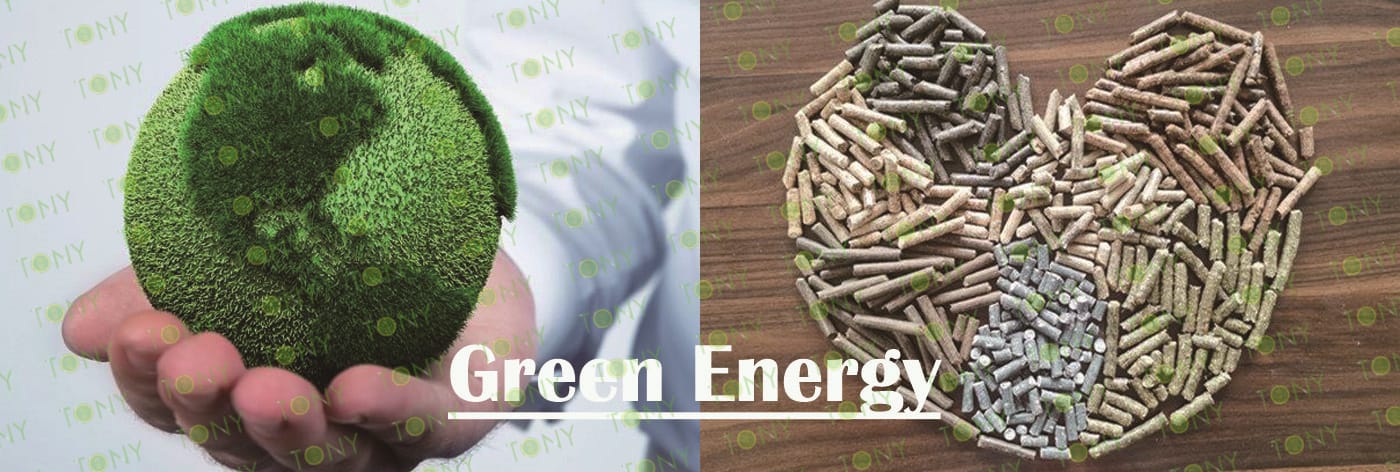
1.The Working Principle Of Wheat Straw Biomass Pellet Processing Equipment
Wheat Straw biomass pellet processing equipment is the bale or packet ofWheat Strawand other biomass raw materials chopped, compressed into pellet fuel processing equipment, its working principle is through the shredder and other pretreatment equipment will be Wheat Straw raw materials chopped, and then pressed through the pelletizing machine, and finally made in line with the quality standards of pellet biomass fuel.
2.Characteristics Of Wheat Straw Biomass Pellet Processing Equipment
(1) Wheat straw biomass pellet processing equipment has the characteristics of high efficiency and low energy consumption, which can quickly process biomass raw materials into fuel pellets, and the production efficiency is greatly improved.
(2) Biomass pellet machine material adaptability, suitable for the molding of various biomass raw materials, pellet machine has a variety of specifications of the mold, according to different biomass raw materials to choose the corresponding mold for processing, improve the adaptability of processing.
(3) The design of wheat straw biomass pellet processing equipment is mature, the finished pellet molding is stable, the output is stable, and the quality is high
(4) Biomass pellet processing equipment is simple to operate, easy to use, high degree of automation, less labor, effectively reduce labor intensity, improve production
3.Application Scenarios Of Wheat Straw Biomass Pellet Processing Equipment
(1) Domestic solid fuel: wheat straw pellet fuel has a high utilization rate, which is conducive to storage, use, health and safety, and can be used for home heating.
(2) The main solid fuel for industrial boilers: replace raw coal, heavy oil and gas to reduce air pollution. Each 10,000 tons of biomass fuel ignited can replace 7,000 tons of standard coal, reduce so2 emissions by 165 tons, smoke and dust emissions by 80 tons, and carbon dioxide emissions by 14,400 tons
(3) Thermal power generation: the fuel heat value can reach 3400~6000 kcal.
Simple words to describe biomass pellet fuel, that is, "environmental protection", "energy saving", "renewable", "zero carbon emissions". Biomass fuel is the best renewable energy to replace coal. From the point of view of cost, energy saving and environmental protection, biomass fuel is a better alternative to coal

As a professional wheat straw pellet factory manufacturer with more than 25 years of history in China. TONY Company can provide customers with a wide range of vertical ring mold wheat Straw and various crop stalk pellet machines.capacityfrom 0.8T/ Hour to 100T/ Hour to customer's demand.
TONY Brand 3-4 Ton/Hour Wheat Straw pellet manufacturing plant can be Wheat Straw, various crop straw, such as corn stalks, cotton straw, soybean straw, etc., with Wheat Straw as raw materials, after pretreatment and processing solidified into high-density straw pellet fuel, which is an ideal fuel to replace coal and oil, and has the role of energy saving and emission reduction. At present, it has been widely used in countries with various crop straw raw materials.
1.Capacity: 3-4 Ton/Hour
2.Raw Materials: Bales of Wheat Straw,corn stalks, cotton stalks, etc.
3.Moisture:Wet type ,about 40-55%.
4.Application: All kinds of Crop straw.
Suitable Customers: Green energy companies, large farms, private growers and other customers with advantages in straw raw materials.
5.Finished Pellets Markets:Large power plants (domestic customers, as well as Japan and South Korea, mainly South Korea more), domestic heating, industrial heating, combustion heat, heating heating, boiler room, school canteen, foundry heat source.

1.Project Name:Wheat Straw Pellet Line
2.Raw Materisl: Bales of Wheat Straw
3.Moisture Of Raw Material: Wet Type 45-55%
4.Capacity:3-4 Ton/Hour
5.Process:Grinding Process-Fine Crushing Process-Drying Process-Pelleting Process-Cooling Process-Packing Process-Palletizer Process
6.Main Machine:Straw Cutter,Hammer Mill, Rotary Drum Dryer,TONY Pellet MachineTYJ551-Ⅲ-110kw,Pellets Cooler,Packing Machine, Automatic Palletizer And Belt Conveyors.
Total Power: About 535KW
Need Area: About 500-600㎡
Project Country: China


|
Project Brief Introduction: 1.Product: Wheat Straw Pellet line. 2.Capacity:3-4T/Hour 4:Main Machine: Straw Cutter,Hammer Mill, Rotary Drum Dryer,TONY Pellet MachineTYJ551-Ⅲ-110kw,Pellets cooler,,Packing Machine, Automatic Palletizer And Belt Conveyors. 5.Total Power: About 535KW 6.Need Area:About 500-6600㎡ 7.Country: China |
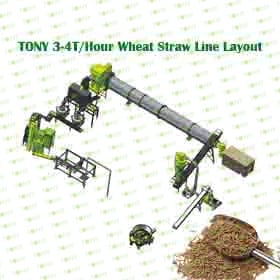 |


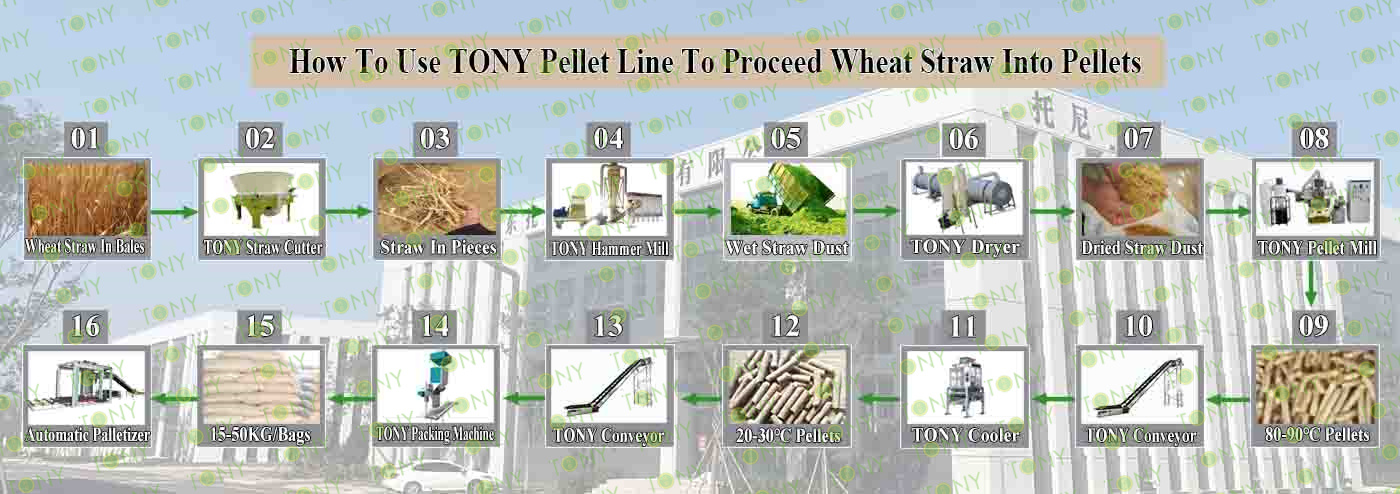
|
How to use TONY pellet line to proceed from wheat straw into pellets? It Mainly Contains The Following Steps And Machines As Following: 1.To Use TONY Straw Cutter To Grind Wheat Straw Balesφ ≤2200mm Into 60-70mm Pieces. 2.To Use TONY Hammer Mill To Crush 60-70mm Bigger Pieces Into 8-14mm Sawdust. 3.To Use TONY Rotary Drum Dryer To Dry The 45-55% Sawdust Into 10-15% Sawdust 4.To Use TONY Vertical Ring Die Pellet Machine To Products Pellets With φ6-8mm. 5.To Use TONY Galvanized Coller To Cool Pellets From 80-90℃ To 20-30℃. 6.To Use TONY Packing Machine To Packing Pellets To 15-50Kg/Bags. 7.To use TONY Automatic Palletizer To stacking 15-50KG Bags with pellets. You Can Contact TONY To Get For More Details Information And Quotation. TONY Can Supply You All Products With Competitive Price And Excellent Quality. |
|
|||||||||||||||||||||||||||||||||||||||||||||||||||||||



Following TONY Will Introduce For You For All The Necessary Machinery That Will Be Used For The Whole Pellet Production Line. Some machines can be custom made by customer according to different customer's detailed demand.Contact TONY for more details with quotation and layout.
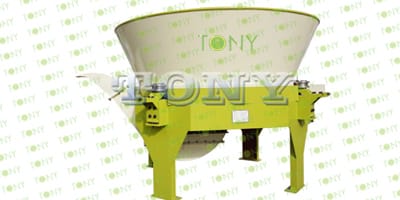 |
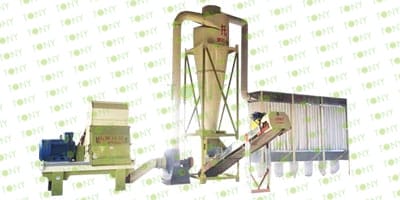 |
 |
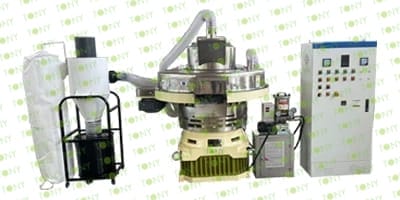 |
| Straw Cutter | High Efficient Hammer Mill | Rotary Drum Dryer | Vertical Ring Die Sawdust Pellet Machine |
|
1.To Grind Wheat StrawBales Diameter <2.2m Into 60-70mm Pieces 2.Model:TPX2500-2blades-24hammers 3.Capacity:1-7Ton/Hour/Sets |
1.Crush 60-70mm Pieces Into 8-14mm Sawdust. 2.Model: TFD75-132 3.Capacity:4-5Ton/Hour/Set |
1.To Dry The 45-55% Sawdust Into 10-15% Sawdust. 2.Model: THGD1.8* 18 3.Capacity:3-4Ton/Hour/Set |
1.Model: TYJ551-Ⅲ-110KW*2 Sets 2.Capacity:1.5-2Ton/Hour/Set 3.New 304SS Type |
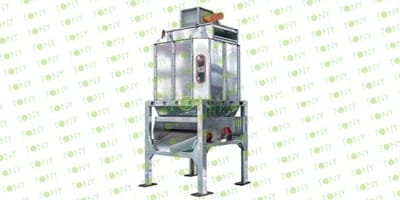 |
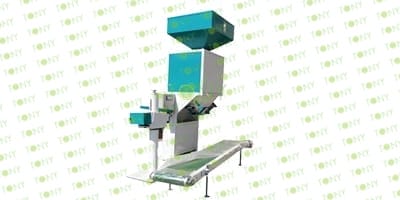 |
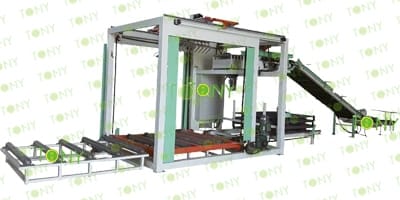 |
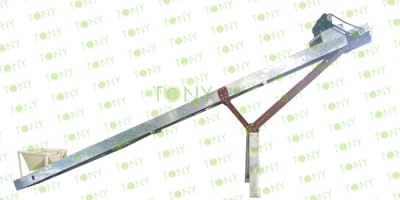 |
| Galvanised Cooler Separator | Dual-Packing Machine | Automatic Palletizer | Belt Conveyor |
|
1.To Cool Pellets From 80-90℃ to 20-30℃ 2.Model:TLN-2.5 3.Capacity::3-4Ton/Hour |
1.Packing Pellets To 15-50KG/Bags. 2.Model:TBF-50 3.Capacity:3-4Ton/Hour |
1.Automatic palletizing bags of pellets 2.Model:TBMG 3.Capacity:3-4Ton/Hour |
1.Transport Straw Pieces,Sawdust,Pellets. 2.Width: 60cm *7Sets 3.Capacity:Designed With The Whole Line |

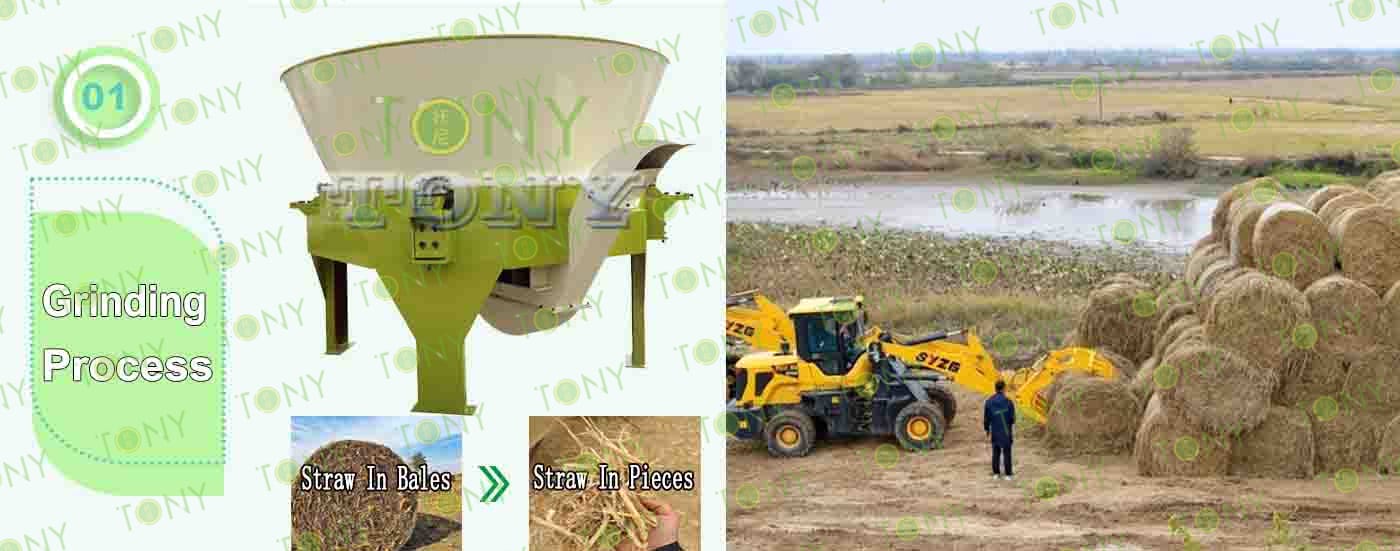
|
1.Grinding Process A.The process is mainly used to grind wheat straw within 2.2m in diameter into wheat straw pieces. The rotary cutting mode of the outer chain of the gear, the rotary cutting rotor blade is sharp, and the blade types are various, which can be rotated to cut various bundles ofwheat straw with different diameters, different thicknesses, different lengths and different water contents B.This customer use TONY Brand TPX2500 model with 2 hard blade and 24 hammers Main Parts: (1)TONY's new rotary cutting machine (2)Turntables that can store large quantities of materials (3)High-quality brand motor, strong power (4)Electronic control system allows the equipment to be used normally (5)Contact TONY for more details with quotation. |
|
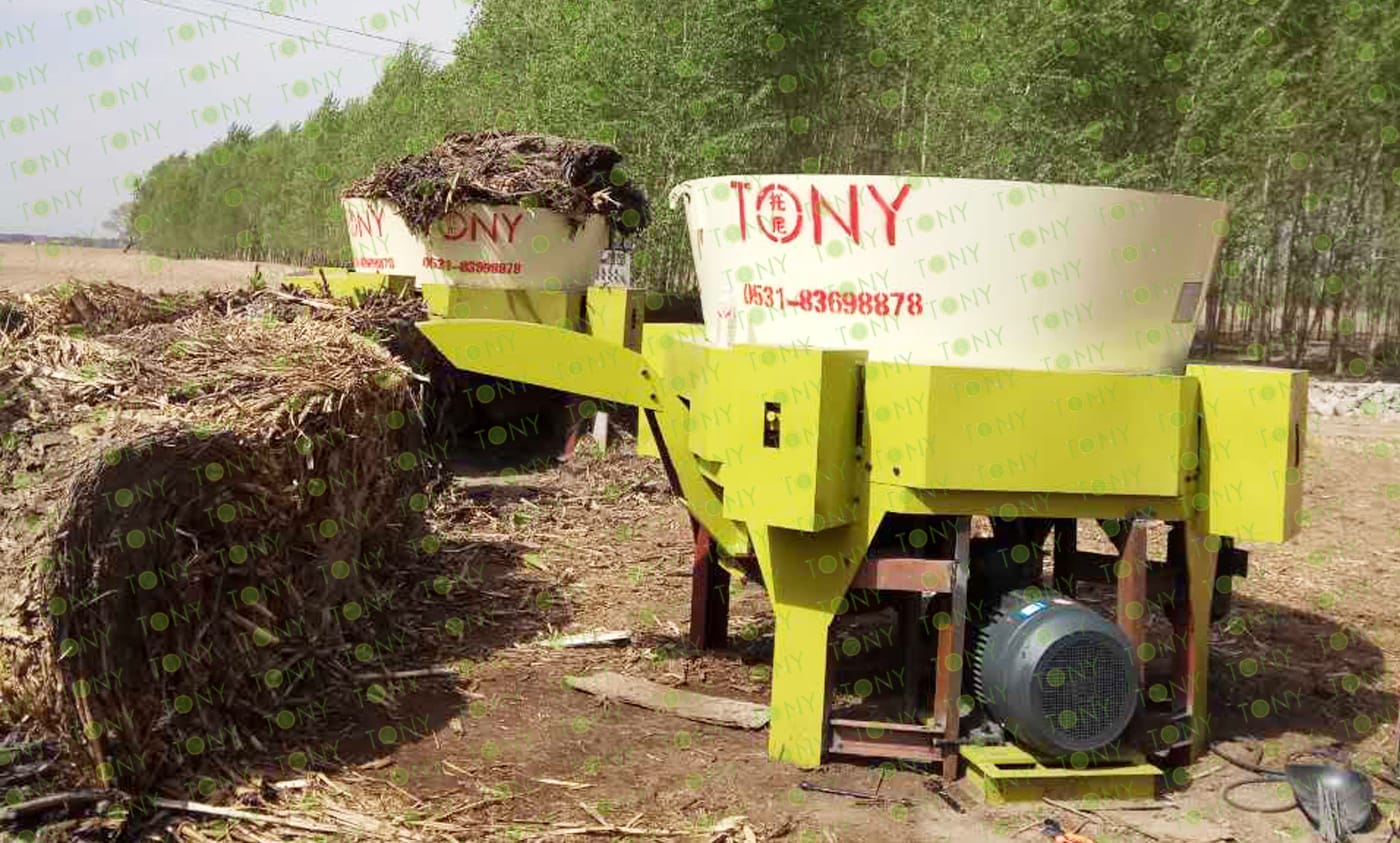

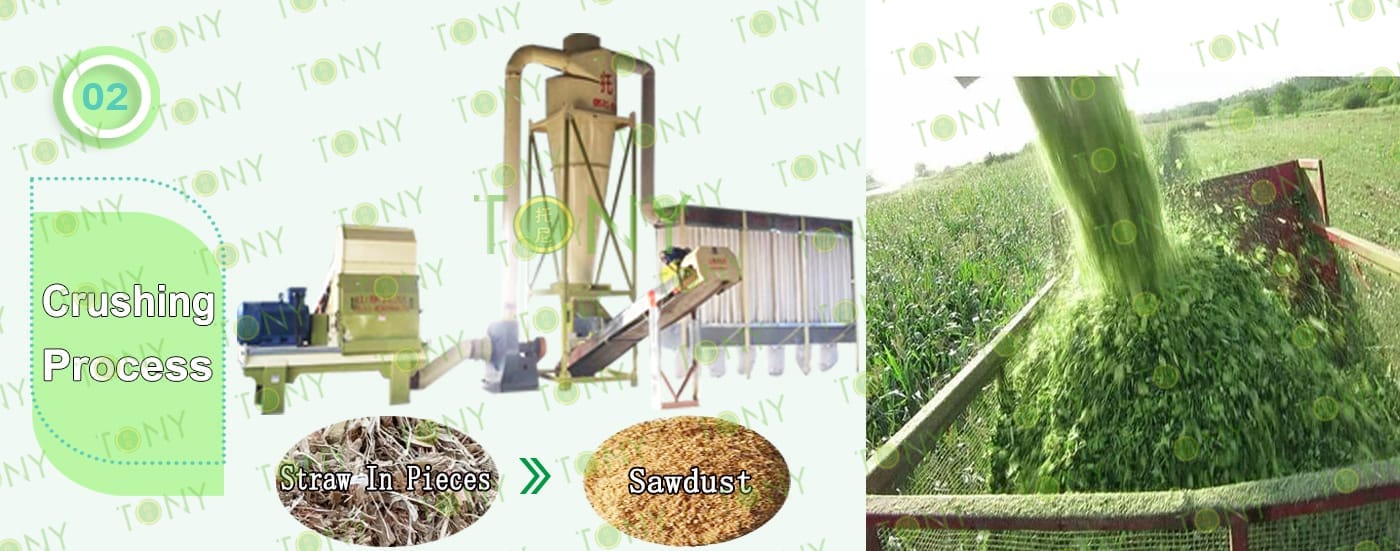
|
2.Fine Crushing Process A. The process is mainly used to crush 60-70mm wheat straw pieces into 8-14mm sawdust. B.Capacity: 4-5 tons/hour. C.TONYuses high efficiency hammer mill TFD75-132KW-1Set. Main parts: (1) TONY high efficiency hammer mill. (2) 90 hole galvanized dust collector. (3) Sawdust conveying fan. (4) Cyclone with airlock. (5) Electrical cabinet. |
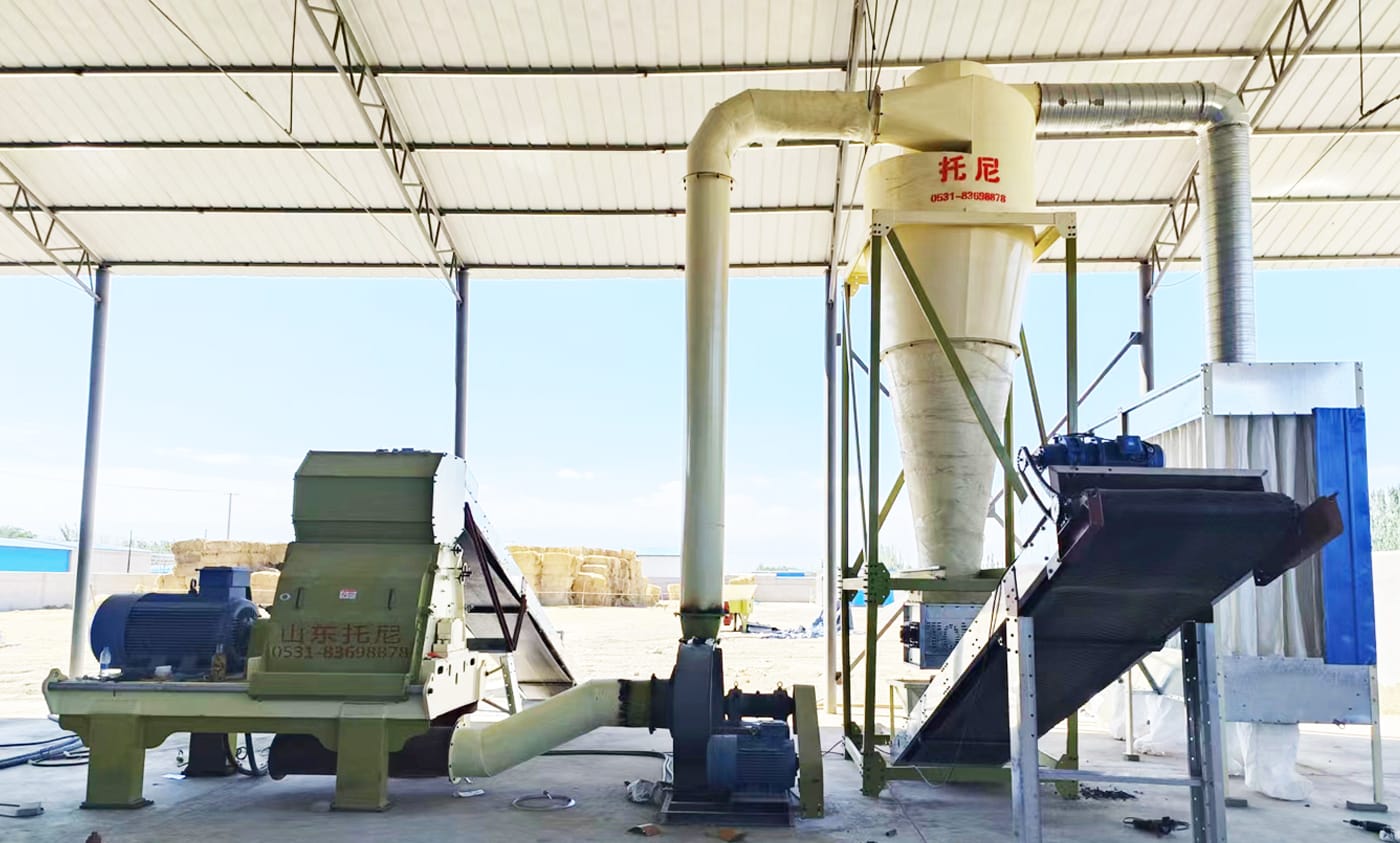


|
3.Sawdust Drying Process: A.This process is mainly used to dry the sawdust from 55% to 10-15%. B.Capacity:3-4Ton/Hour. C.TONY use 1set of 1.8*18m single layer rotary drum dryer for this process,this customer use biomass waste wood as buring raw material with hot stove 4*2*2m.TONY hot blast stove is made of firebrick pan, shell with H steel plate as the frame. There are 3 layers of fire blocking device inside, which can effectively prevent the fire from entering the tumble dryer. TONY dryer use spiral tube material, which has higher heart rate and is not easy to deform. Unlike other manufacturers with iron plate splicing welding, very easy to deformation. Main Parts: (1)TONY's Rotary Drum Dryer Main Body.(Reducers With Motors and Pips.) (2)TONY's Wood Waste Hot Stove. (3)Fan Blower+Cyclone With Airlock. |
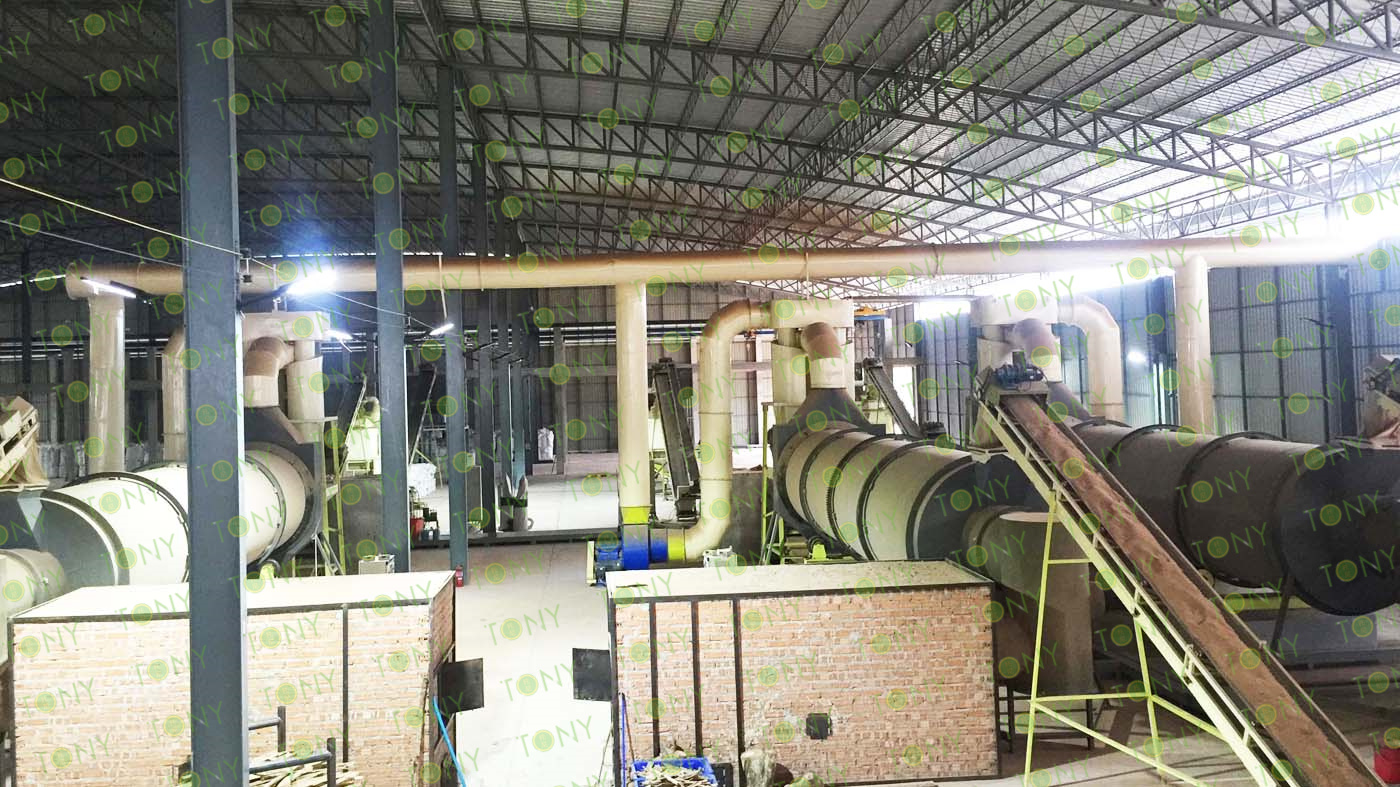


|
4.Pelleting Process: A.This process is mainly used To Products Pellets With φ6-8mm. Biggest Capacity: 1.5-2 Ton/Hour/Set. C.The Customer Chose 2 Set OfTONY Brand Vertical Ring Die Pellet Machine TYJ 551-Ⅲ-110Kw Total Capacity 3-4 Ton/Hour. Main Parts: (1).TONY's new vertical ring die pellet machine. (2)Cyclone and bags dust collectors. (3)Bearings automatic lubrication system. (4)Electrical cabinets. You can chose TONY new type SS304 pellet machine or old type MS pellet machine. |
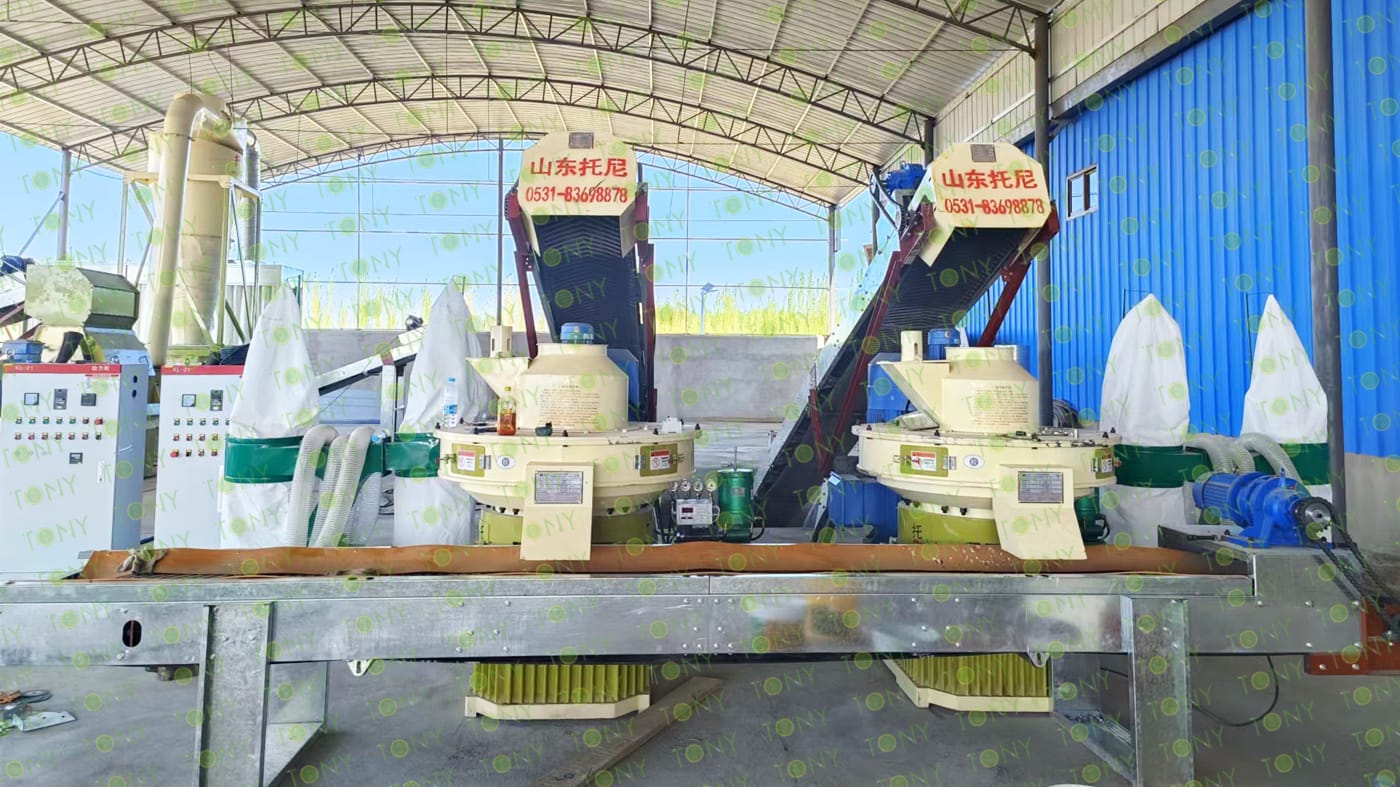

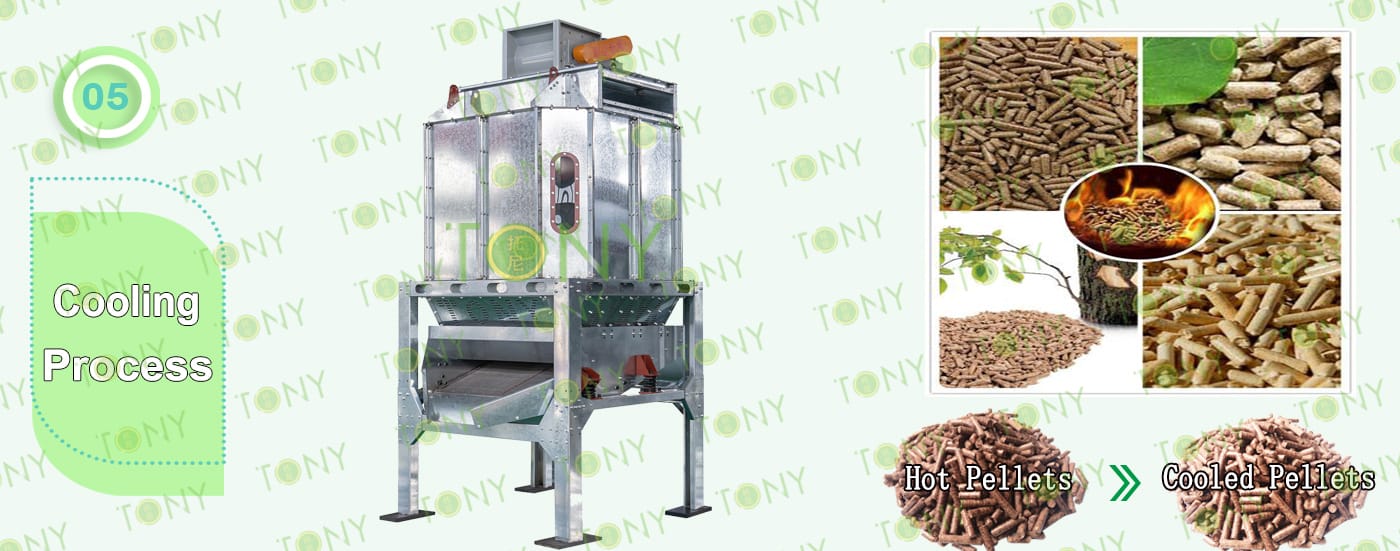
5.Cooling Process:
A.This process is mainly used to To Cool Pellets From 80-90℃ to 20-30℃
B.The Customer Chose 1Set Of TONY Galvanized Cooler Separator With Capacity 3-4Ton/Hour
Main Parts:
(1)TONY's new Galvanized Cooler Separator With Vibrating Screen.
(2)Cyclone and bags dust collectors.
(3) Fan Blower.
(4)Connect Pipes.
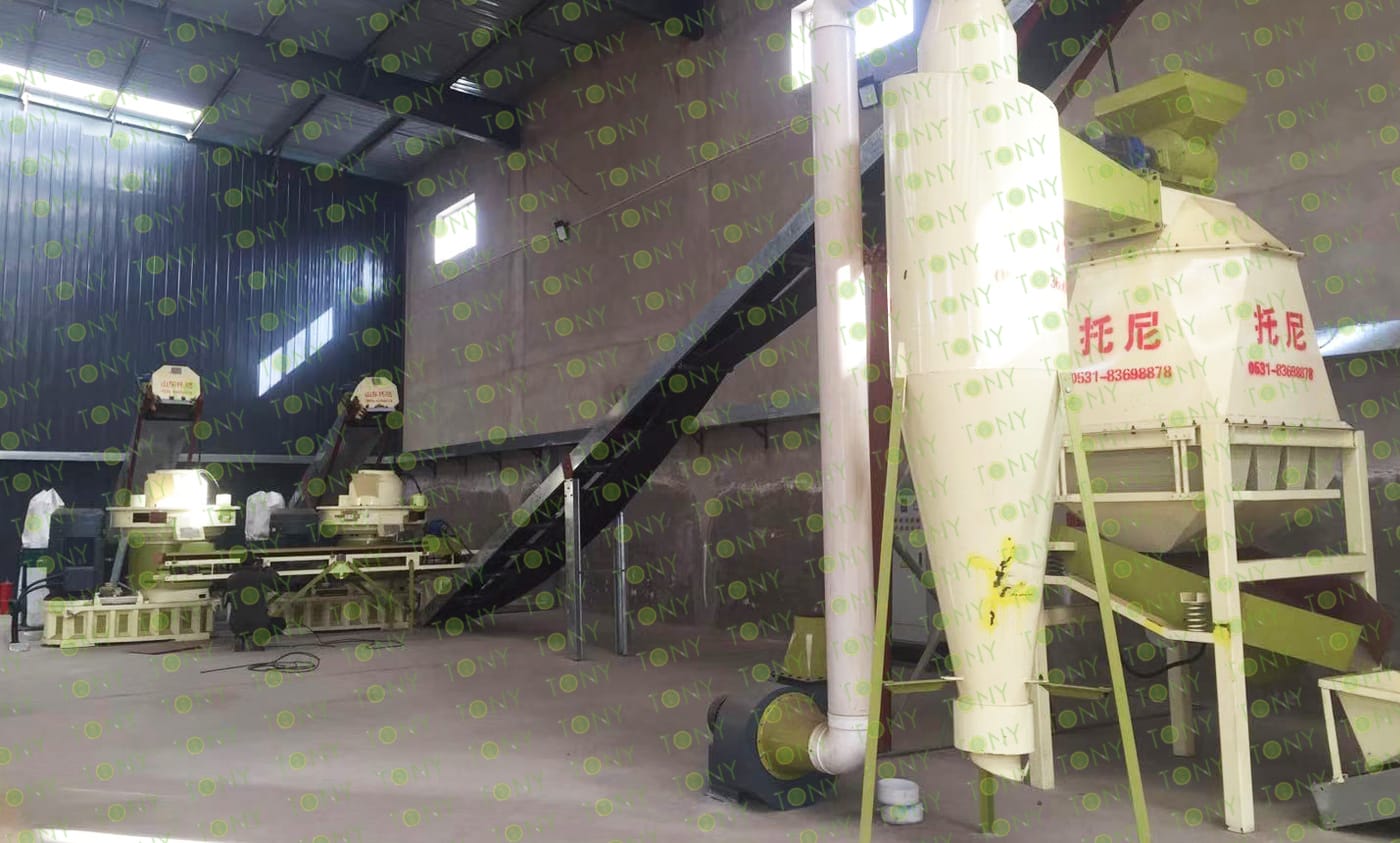

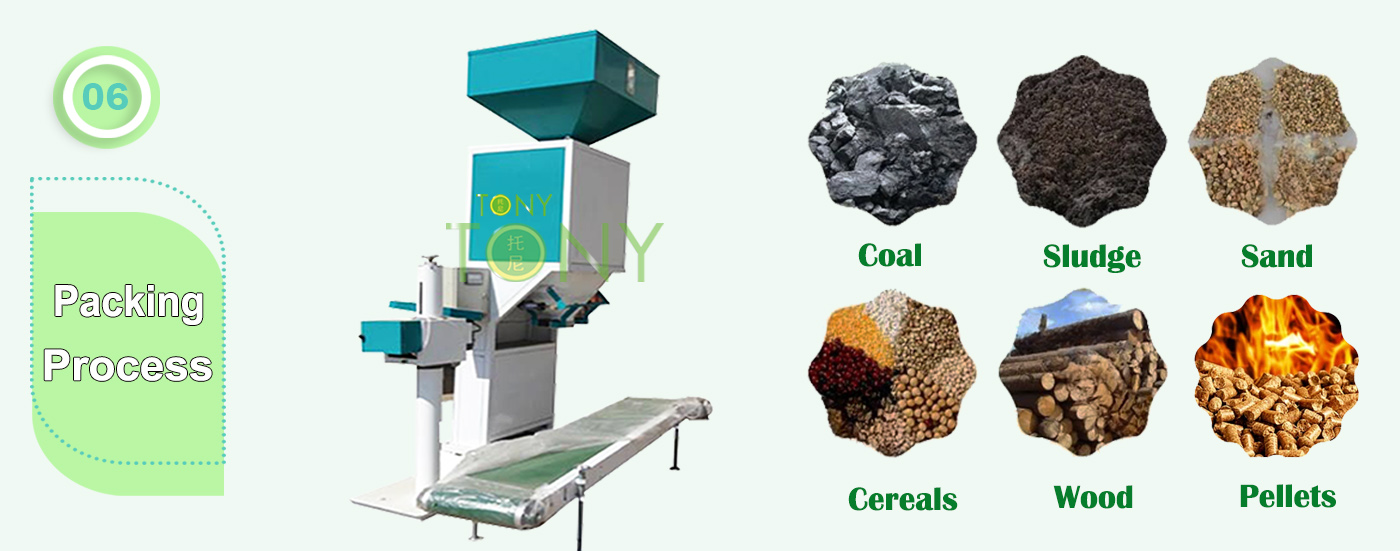
6. Packing Process:
A.This process is mainly used to Dual-Packing Pellets To 15-50KG/Bags
B.The Customer Chose 1 Set OfTONY Packing Machine With3-4Ton/Hour;
Main Parts:
(1)TONY's new TONYDual-Packing Machine
(2)Sew Machine,Buyer Can Also Chose Hot Seal Machine For Chosen,To Confirm With TONY For The Price Difference.
(3)Bags Transportation Conveyors.
(4)Feeding Inlet Silo With 1㎥.
(5)Electrical cabinets.



7.Palletizer process:
A.This process is mainly used to Palletizing pellets in bags,which will reduce the labor, and it will effectively improve work efficiency, and realizes automated production.
B.The Customer Chose 1Sets Of TONY Automatic Palletizer Machine With 5-6Ton/Hour.
Main Parts:
1).TONY's newTONY Automatic Palletizer Machine whole set.
2).Natural bag emptying machine:Transfer by mechanical structure.
3).Climbing conveyor:Transfer the material to the transition flat belt to be coded.
4).Downshift system and capture area combination:The finished product is packed through the square roller to complete the whole package.
After the whole package is completed, it is transferred to the waiting area for grabbing.
5).Safety guardrail, pallet limit and safety testing, quantity: 1 set, Material: carbon steel, spray paint.
6).Lift empty tray motor: 4KW.
7).Roller shock transfer system for upper levelling.
8).Lower vibration feed and roller to be grabbed.
9).Tray automatic storage system。
10).Electrical cabinets.
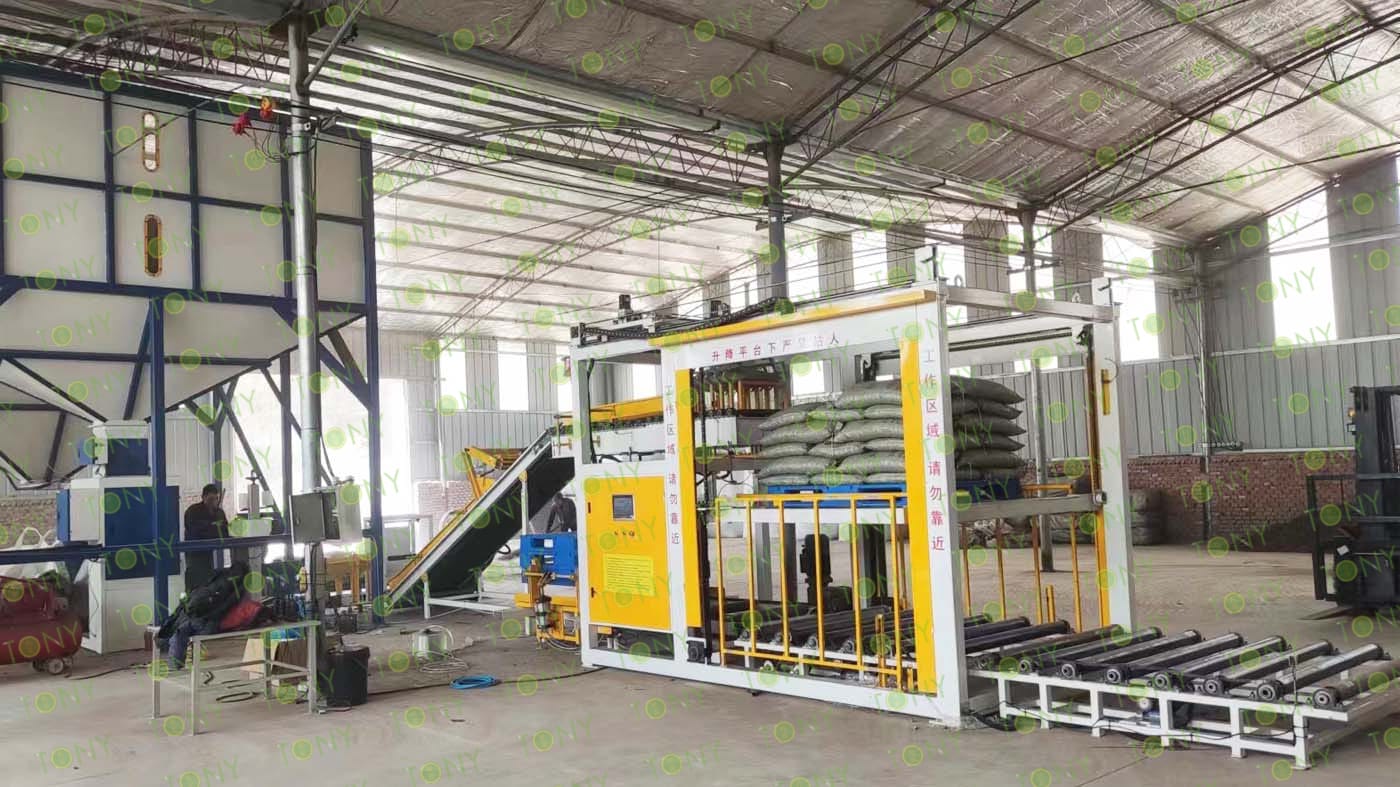

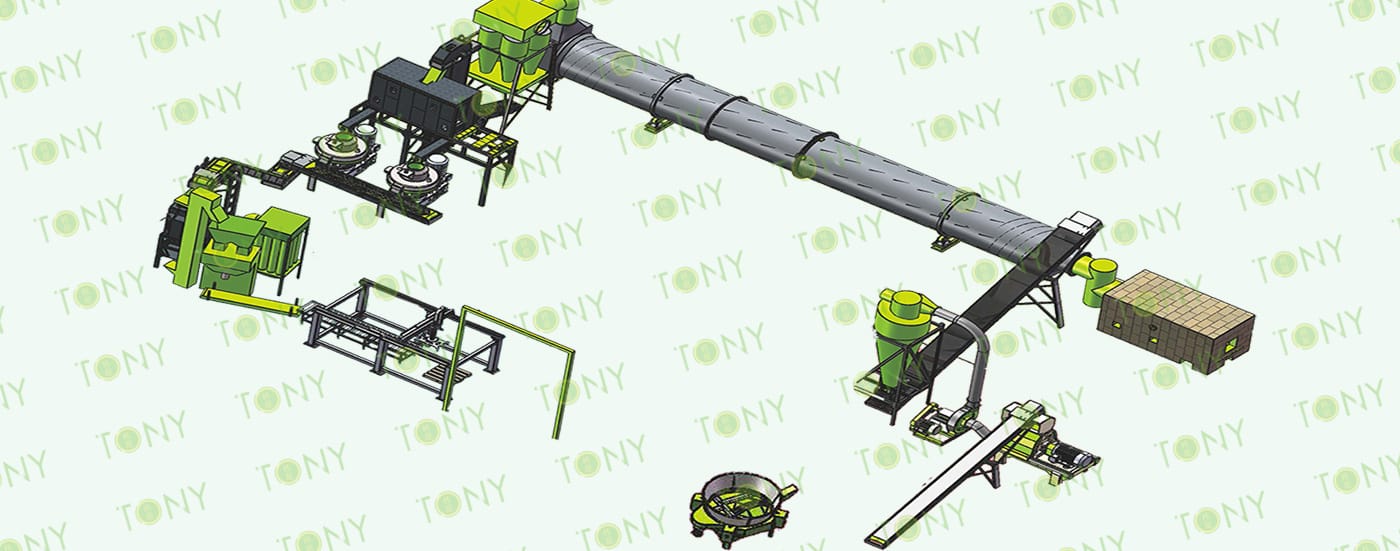

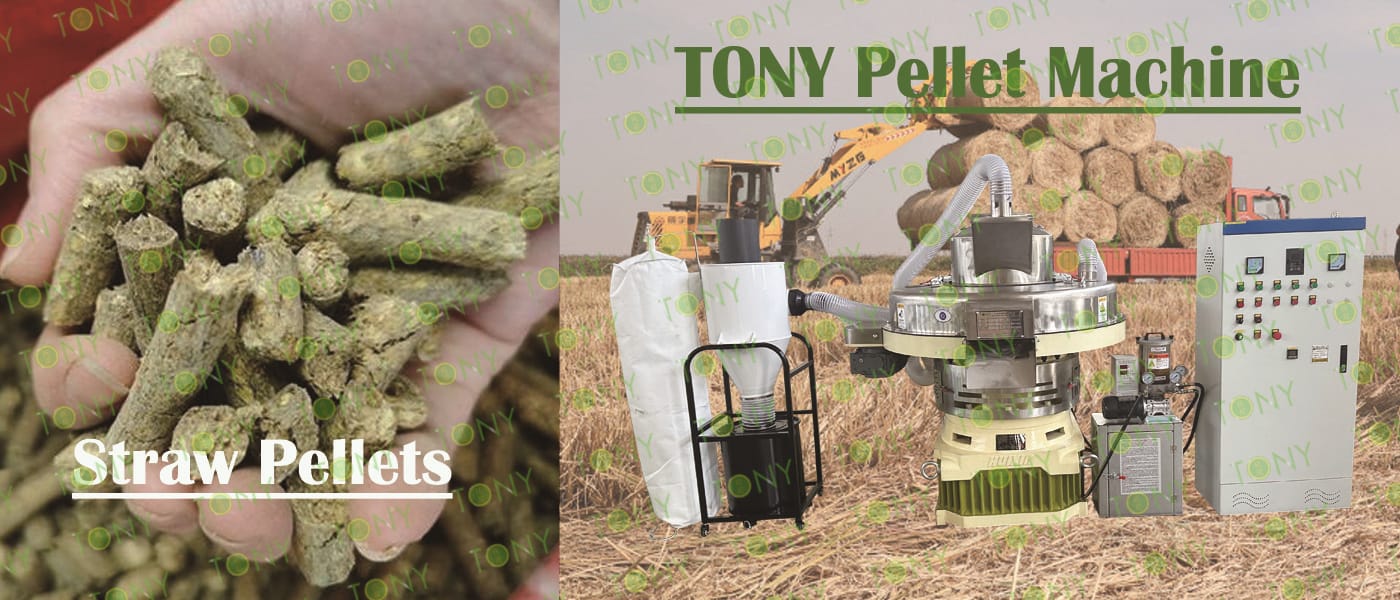
1. With the increasing energy and environmental crisis, biomass energy has been paid more and more attention as a renewable and clean energy. Taking wheat straw as an example, the deep exploitation potential is very great. Biomass utilization can be divided into many kinds, and processing biomass into compressed pellet fuel is an advanced biomass utilization way. The content of S in biomass pellet fuel is less than 1/10 of coal, and its replacement of coal combustion can effectively reduce the emission of SO2 in the atmosphere, and the ash generated after combustion is an excellent natural fertilizer. At present, biomass pellet gasification combustion is a clean and environmentally friendly combustion mode, which is of great significance to reduce pollution emissions and protect the atmospheric environment.
2. As a very important agricultural resource in agricultural production, wheat straw is very common in rural areas and the amount is very huge, there has been no good treatment method, if the on-site incineration, then it will cause pollution to the environment, and choose wheat straw as raw materials for biomass particles, there is a very low raw material cost. If there is a large amount of wheat resources in or around it, it is equivalent to zero raw material costs.
3. Biomass fuel is not only environmentally friendly but also provides a choice for the country's energy needs. The market demand for biomass fuel is increasing, and the price of biomass pellet energy made of wheat straw is also steadily increasing. For entrepreneurial projects, there is a very considerable profit margin. Therefore, the use of wheat straw to produce biomass pellets is multiple. In addition to protecting the environment and helping to solve employment problems, there are considerable economic and energy sustainability

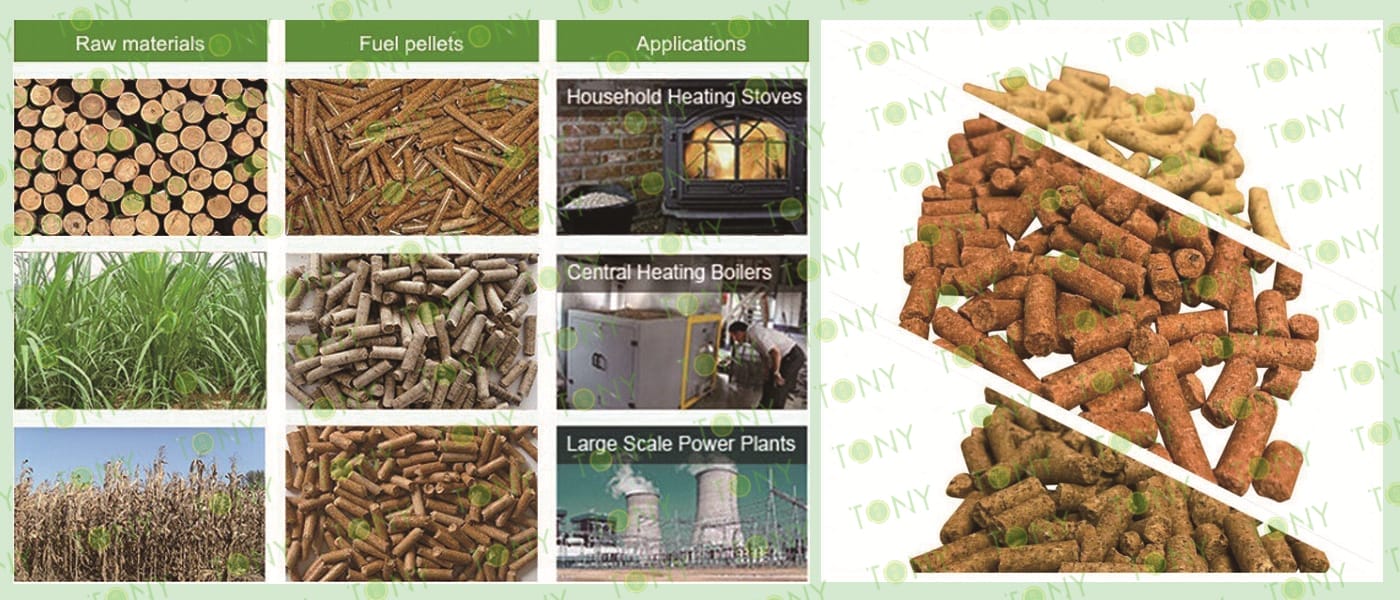
Advantages of Wheat Straw as biomass pellet fuel:
The combustion performance of biomasspellet s is not only reflected in environmental protection and economy, as well as the impact on social development and the improvement of energy structure, but also has its own unique combustion performance advantages, which are mainly reflected in the following points:
1. The calorific value and ash content after combustion of biomass pellet fuel are about 10% lower than that of medium coal. However, biomass pellet fuel burns out in the working situation, while coal can not burn out, and the cinder remains 10% to 15% of the combustible composition. Therefore, the calorific value of the two is comparable in actual use.
2. The ignition property of biomass pellet fuel is better than that of coal, and it is easy to ignite, which greatly reduces the ignition time.
3. The solid emission of biomass pellet fuel is lower than that of coal, which reduces the cost of discharging slag and environmental pollution. The solid emission of biomass pellet fuel is all ash, accounting for about 0.4%~7.0% of the total weight; The solid emissions from coal combustion are a mixture of ash, alkali and residual coal, about 25% to 40% of the total weight.
4. The degree of air pollution and boiler corrosion of coal is much greater than that of biomass pellet fuel. Soot contains a large number of granular C and toxic SO2, CO and other corrosive gases. The main component of biomass pellet fuel is C-H organic matter, there is no granular C and SO2 gas in the flue gas, mainly C-H volatile gas, and its SO2 and CO emissions are close to zero. When burned, the smoke color is less than Ringelmann 1, which will greatly reduce air pollution and carbon dioxide emissions, and biomass pellet fuel is known as a "clean fuel" in the international reputation.
5. The cost and time of using biomass pellet fuel for boiler fuel is less than that of burning coal. A 0.5t boiler burning biomass pellet fuel costs 11% less than burning coal, saving 34% of time, a 0.5t boiler fuel costs relative to coal reduced 10%, saving 16% of time.
6. The continuous combustion time of general biomass pellet fuel is 8 to 10 times higher than that of soft bulk material, and it is in a stable and continuous combustion state.


1. Characteristics And Application Scope Ofwheat Straw Pellet Fuel
Crop straw pellet fuel technology belongs to the field of biomass energy application, without adding any additives, wheat straw, corn straw, cotton stalk, soybean stalk and other crop straw into pellet fuel, with high density, high molding rate, high caloric value, clean and clean, no pollution, convenient storage and transportation and many other advantages. The product can not only be used as fuel for special boilers, heating furnaces, fireplaces, etc., but also as feed for livestock.
2. Current Situation Of Wheat Straw Pellet Fuel Market Demand Pellet Fuel Market Demand
Current market demand:
(1) Production Growth: Biomass pellet production has continued to grow in recent years, and with the advancement of technology and the expansion of market demand, production is expected to further increase.
(2) Technological Development: biomass pellet production technology continues to improve, including raw material pretreatment, molding process, drying technology, etc.
(3) Market Application: Biomass particles are widely used in heating, power generation, industrial boilers and other fields, and the market demand continues to expand.
(4) Policy Promotion: The state has introduced a series of policies and measures to encourage the development and utilization of biomass energy, including tax incentives, financial subsidies and so on.
(5) Standard Formulation: Relevant departments have formulated quality standards and production specifications for biomass pellets to ensure product quality and the healthy development of the industry.
With the increase in global demand for renewable energy and the concern to reduce greenhouse gas emissions, biomass energy as a clean energy alternative to fossil fuels, has been rapidly developed, and many countries are actively promoting the development and utilization of biomass energy.
3.Analysis Of Pellet Fuel Market Prospects Of Wheat Straw
With the development of economy and the improvement of people's living standards, the demand for energy is growing. As a renewable energy source, the market demand for biomass pellets continues to expand. With the rapid development of the industry, the upstream and downstream industry chain of biomass particles has gradually improved, including raw material supply, production and processing, logistics distribution, marketing and other links, forming a relatively complete industrial system.
Biomass particles are not only used for power generation and heating, but also widely used in industrial production, agricultural breeding, domestic energy and other fields, and the expansion of the application scope has further promoted the development of the industry.
The biomass pellet industry has shown a good development trend under the promotion of policy support, market demand, technological progress and other factors. In the future, with the further implementation of relevant policies and the continued growth of market demand, the biomass pellet industry is expected to achieve more rapid development.

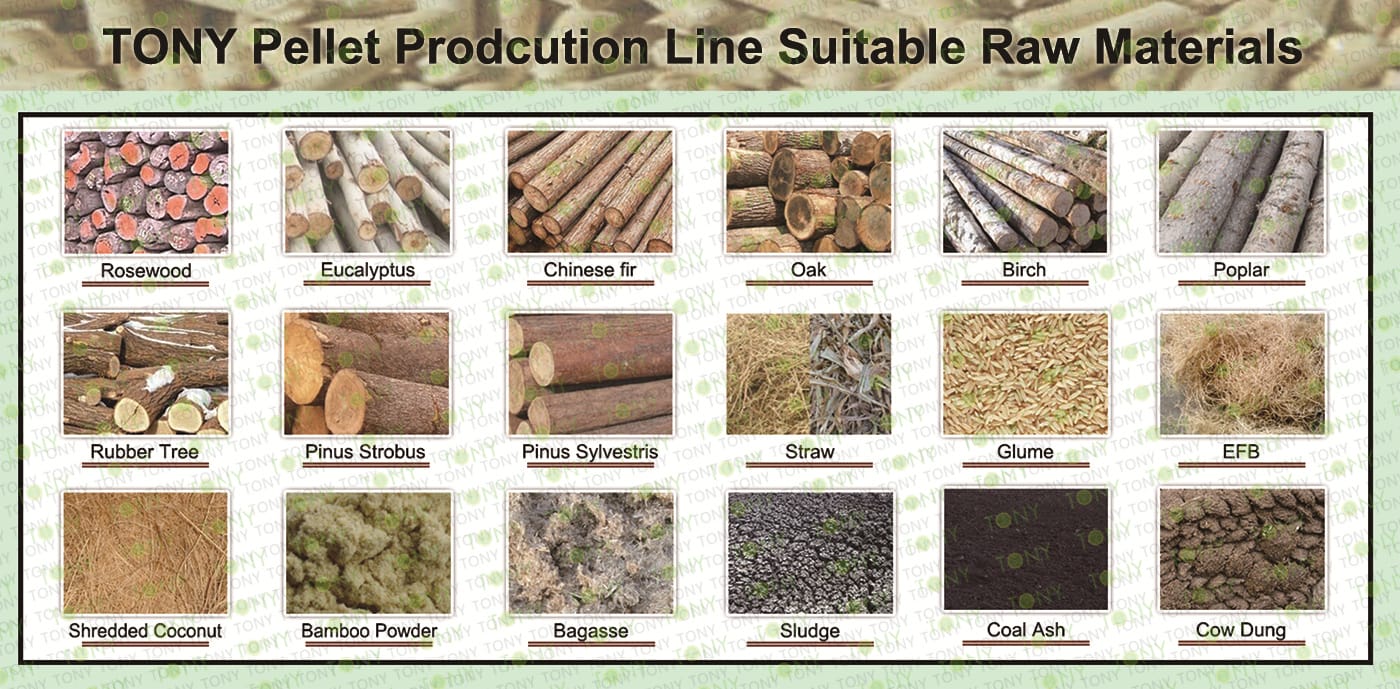
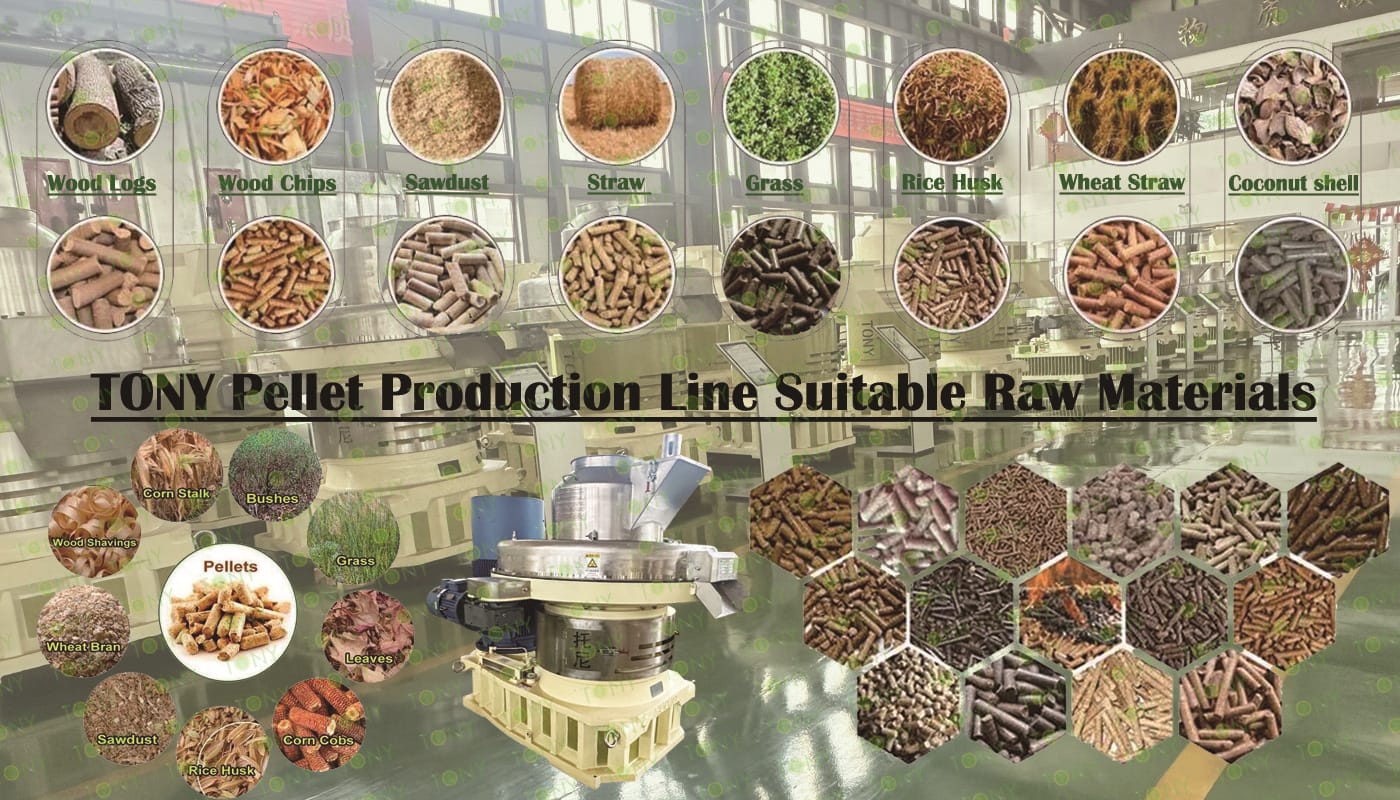



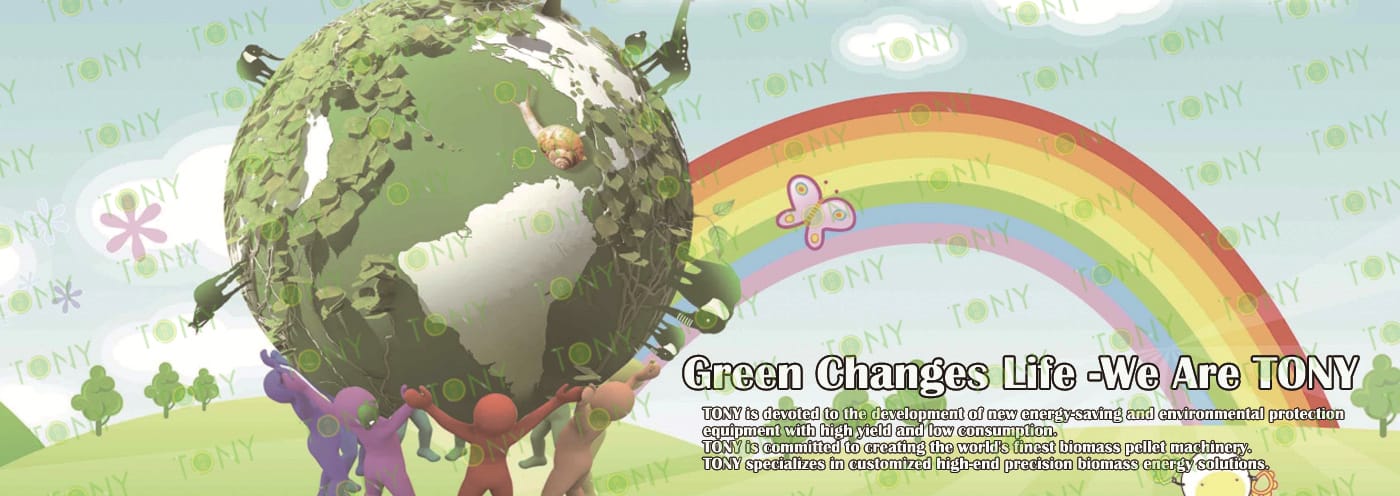
2025 Tony Machinery - All Rights Reserved. Map